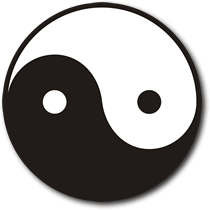"Every empty soaker yearns to be filled; every filled soaker yearns to be emptied." - Z.o.S.
The Yin & Yang (陰陽) is one of the cornerstones behind most branches of Chinese philosophy. The dual concepts of yin and yang (or heaven and earth) describe two primal opposing yet complementary principles found in all non-static objects and processes in the universe. Yin (陰) is the dark element; it represents passive, dark, feminine, negative, downward-seeking, consuming and corresponds to the night. Yang (陽) is the bright element; it represents active, light, masculine, positive, upward-seeking, producing and corresponds to the daytime. Yin is often symbolized by water and earth while yang is symbolized by fire and air.
The Taijitu (太極圖; pictured below) is literally "diagram of the supreme ultimate" and is often referred to as yin-yang in English. This is possibly one of the best known symbols representing the principle of yin and yang from Taoist philosophy. The taijitu represents an ancient Chinese understanding of how things work.
The outer circle represents the entirety of perceivable phenomena, while the black and white shapes within the circle represent the interaction of two principles. The image below showing yin-yang is a circle (representing the initial unity of universe) with two equal parts These two parts pass through each other on a line because yin and yang are never separated (i.e. there can be no bad if there is no good to compare it with). There is a small black round in white part and so is in black part; that presents the philosophy: "yang in yin, yin in yang" (i.e.: though water is fluid-yin, water is also hydraulic-yang); if yin is not in yang, yang is not yang and so (everything has two aspects). Neither dark nor light part is a semicircle since there is never an absolute balance between yin and yang. There is always having a stronger aspect and a weaker aspect; that presents the philosophy: "Whenever yin is stronger, yang is weaker and so". If the circle is divided into two by any diameter, black or white colour never cover all of the area of a segment because universe is never in all yin or all yang. When both parts are put together in a circle; that is unity. However, on the opinion of motion, the two parts are contradicting aspects, they fight and interchange each other; whenever the trend of yin increases, the trend of yang decreases and vice versa. At the specific time when yin is extreme, yin starts to grow into yang and so (for example: day after night, night after day). The unity maintains universe and the contradiction is the stimulation for its development.

In the Realm of the Water Warrior :.
The Water Warrior accepts the fundamental dual-nature of the universe as a given and employs this knowledge to harness the flows of change. There can be no soak if there is no dry. There is no victor without another suffering defeat. With focus and training, an enlightened Water Warrior will be able to innately sense levels of Yin and Yang that surround him, adapting his own actions and directions based on the flow of force that surrounds.

However, as there is never an absolute balance between the yin and yang, the enlightened Water Warior strives to remain slightly on the yang side, sending yin towards his opponents while preserving more yang for himself. As should now be apparent, this is the essence of the successful soak.
Some Information Adapted from Wikipedia - http://en.wikipedia.org/wiki/Yin_and_yang


